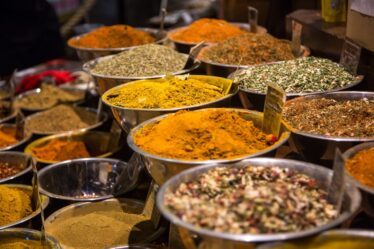
Soy sauce is a staple ingredient in Asian cooking, known for its ability to enhance flavors and add depth to dishes. It is a dark, salty liquid made from fermented soybeans, wheat, water, and salt. Soy sauce has a rich history and has been used in Asian cuisine for centuries. It is commonly used in marinades, stir-fries, soups, and dressings, among other dishes.
Key Takeaways
- Soy sauce is a popular seasoning in Asian cuisine.
- Soy sauce has a long history and has evolved as a flavor enhancer.
- There are different types of soy sauce with unique characteristics.
- Soy sauce can be used as a marinade, in stir-fries, soups and stews, salad dressings, and dipping sauces.
- Soy sauce can be used in fusion cuisine to combine traditional and modern flavors.
The History and Evolution of Soy Sauce as a Flavor Enhancer
Soy sauce originated in China over 2,500 years ago and was initially used as a way to preserve fish. The process of making soy sauce involves fermenting soybeans with wheat or other grains, which creates a complex flavor profile. Over time, soy sauce spread to other parts of Asia, including Japan, Korea, and Southeast Asia.
As soy sauce spread throughout Asia, different regions developed their own unique types of soy sauce. For example, Japanese soy sauce is typically lighter and sweeter than Chinese soy sauce. Korean soy sauce is often darker and saltier. Each type of soy sauce has its own distinct characteristics and flavors.
The influence of soy sauce on global cuisine cannot be overstated. It has become a popular ingredient in many non-Asian dishes as well. Chefs around the world have embraced the umami-rich flavor of soy sauce and use it to add depth to their creations.
Understanding the Different Types of Soy Sauce and Their Unique Characteristics
There are several different types of soy sauce, each with its own unique characteristics. The most common types are light soy sauce, dark soy sauce, and thick soy sauce.
Light soy sauce is the most commonly used type of soy sauce in Asian cooking. It is thin and salty with a light color. Light soy sauce is often used for seasoning dishes during cooking or as a dipping sauce.
Dark soy sauce is thicker and darker in color than light soy sauce. It has a richer, more intense flavor and is often used to add color and depth to dishes. Dark soy sauce is commonly used in marinades, braises, and stir-fries.
Thick soy sauce, also known as sweet soy sauce or kecap manis, is a syrupy, sweet version of soy sauce. It is commonly used in Indonesian and Malaysian cuisine to add sweetness and depth of flavor to dishes.
Each type of soy sauce has its own unique taste, color, and texture, making them suitable for different culinary applications. It is important to choose the right type of soy sauce for each dish to achieve the desired flavor profile.
Soy Sauce as a Marinade: How to Infuse Meat and Seafood with Flavor
| Meat/Seafood | Soy Sauce Marinade Recipe | Marinating Time | Resulting Flavor |
|---|---|---|---|
| Beef | 1/2 cup soy sauce, 1/4 cup olive oil, 1/4 cup Worcestershire sauce, 2 tablespoons honey, 2 teaspoons minced garlic | 4-6 hours | Savory and slightly sweet |
| Chicken | 1/2 cup soy sauce, 1/4 cup honey, 2 tablespoons rice vinegar, 1 tablespoon sesame oil, 1 teaspoon minced garlic | 2-4 hours | Sweet and tangy |
| Salmon | 1/4 cup soy sauce, 1/4 cup brown sugar, 2 tablespoons olive oil, 1 tablespoon rice vinegar, 1 teaspoon minced garlic | 30 minutes | Sweet and savory |
| Shrimp | 1/4 cup soy sauce, 1/4 cup honey, 2 tablespoons lime juice, 1 tablespoon olive oil, 1 teaspoon minced garlic | 15-30 minutes | Sweet and tangy |
Soy sauce is a popular choice for marinades because it adds depth of flavor and helps tenderize meat and seafood. The saltiness of soy sauce helps to season the protein while the umami-rich flavor enhances the overall taste of the dish.
To create a flavorful marinade with soy sauce, start by combining soy sauce with other ingredients such as garlic, ginger, honey, or citrus juice. The combination of these flavors will infuse into the meat or seafood during the marinating process.
When marinating with soy sauce, it is important to consider the marinating time. For delicate proteins like fish or shrimp, a short marinating time of 15-30 minutes is sufficient. For tougher cuts of meat like beef or pork, marinating for several hours or overnight will help tenderize the meat and allow the flavors to penetrate.
Some examples of dishes that can be marinated with soy sauce include teriyaki chicken, soy-glazed salmon, and Korean bulgogi. The possibilities are endless when it comes to using soy sauce as a marinade.
Soy Sauce in Stir-Fries: Adding Depth and Umami to Your Wok Dishes
Stir-frying is a popular cooking technique in Asian cuisine, and soy sauce plays a crucial role in enhancing the flavors of stir-fried dishes. The high heat of the wok caramelizes the sugars in the soy sauce, creating a rich, savory flavor.
To incorporate soy sauce into stir-fries, start by heating oil in a wok or skillet. Add aromatics such as garlic, ginger, and onions, followed by your choice of protein and vegetables. Once the protein is cooked through and the vegetables are tender-crisp, add soy sauce to the wok and toss everything together to coat.
The soy sauce not only adds flavor to the stir-fry but also helps to create a glossy, caramelized coating on the ingredients. It adds depth and umami to the dish, making it more satisfying and flavorful.
Some popular stir-fry dishes that use soy sauce include beef and broccoli, chicken stir-fry with vegetables, and shrimp fried rice. The combination of soy sauce with other ingredients creates a harmonious balance of flavors.
Soy Sauce in Soups and Stews: Creating Rich and Savory Broths

Soy sauce can be used to add depth and richness to soups and stews. It helps to create a savory broth that is full of umami flavor.
To incorporate soy sauce into soups and stews, start by sautéing aromatics such as onions, garlic, and ginger in a pot. Add your choice of protein, vegetables, and broth. Towards the end of cooking, add soy sauce to taste. The soy sauce will enhance the flavors of the soup or stew and give it a rich, savory taste.
When using soy sauce in soups and stews, it is important to taste as you go and adjust the amount of soy sauce accordingly. Start with a small amount and add more if needed. Remember that soy sauce is salty, so you may need to adjust the amount of salt in the recipe.
Some examples of soups and stews that use soy sauce include miso soup, ramen, and Korean soybean paste stew. The addition of soy sauce elevates these dishes and gives them a complex, savory flavor.
Soy Sauce in Salad Dressings: Elevating Simple Greens with Complex Flavors
Soy sauce can be used to add complexity to salad dressings, transforming a simple bowl of greens into a flavorful and satisfying meal. The umami-rich flavor of soy sauce pairs well with a variety of ingredients and can take your salad dressing to the next level.
To create a flavorful dressing with soy sauce, start by combining soy sauce with other ingredients such as vinegar, citrus juice, honey, or sesame oil. The combination of these flavors will create a well-balanced dressing that complements the ingredients in your salad.
When using soy sauce in salad dressings, it is important to consider the saltiness of the soy sauce. You may need to adjust the amount of salt in the recipe accordingly. Taste as you go and add more soy sauce or other ingredients as needed.
Some examples of salads that use soy sauce in their dressings include Asian-inspired salads with sesame dressing, Chinese chicken salad with soy ginger dressing, and Thai beef salad with soy lime dressing. The addition of soy sauce adds depth and complexity to these salads, making them more flavorful and satisfying.
Soy Sauce in Dipping Sauces: Perfect Pairings for Dumplings, Sushi, and More
Soy sauce is commonly used as a dipping sauce for a variety of dishes, including dumplings, sushi, spring rolls, and more. It adds a salty, umami-rich flavor that complements the flavors of the dish.
To create a flavorful dipping sauce with soy sauce, start by combining soy sauce with other ingredients such as rice vinegar, sesame oil, garlic, ginger, or chili flakes. The combination of these flavors will create a well-balanced dipping sauce that enhances the flavors of the dish.
When using soy sauce as a dipping sauce, it is important to consider the saltiness of the soy sauce. You may need to adjust the amount of salt in the recipe accordingly. Taste as you go and add more soy sauce or other ingredients as needed.
Some examples of dishes that pair well with soy sauce dipping sauces include potstickers, gyoza, sushi rolls, and spring rolls. The combination of soy sauce with these dishes creates a harmonious balance of flavors.
Soy Sauce in Fusion Cuisine: Combining Traditional and Modern Flavors
Soy sauce can be used in fusion cuisine to combine traditional Asian flavors with modern techniques and ingredients. Chefs around the world have embraced the versatility of soy sauce and use it to create innovative and exciting dishes.
In fusion cuisine, soy sauce can be used in a variety of ways. It can be incorporated into marinades, stir-fries, soups, dressings, and more. The umami-rich flavor of soy sauce adds depth and complexity to dishes, making them more interesting and flavorful.
Some examples of dishes that combine traditional Asian flavors with modern techniques and ingredients include soy-glazed salmon with quinoa salad, teriyaki chicken tacos with avocado salsa, and Korean BBQ sliders with kimchi slaw. These dishes showcase the versatility of soy sauce and how it can be used to create unique and delicious flavor combinations.
The Endless Possibilities of Soy Sauce in the Kitchen
In conclusion, soy sauce is a versatile ingredient that plays a crucial role in Asian cuisine and beyond. It enhances flavors, adds depth to dishes, and creates a rich umami taste. Whether used as a marinade, stir-fry sauce, soup base, salad dressing, or dipping sauce, soy sauce has the ability to transform ordinary dishes into extraordinary ones.
The history and evolution of soy sauce have shaped the way we cook and eat today. From its origins in China to its spread throughout Asia and the world, soy sauce has become a staple in many kitchens. Its unique characteristics and flavors have influenced global cuisine and continue to inspire chefs and home cooks alike.
As you explore the possibilities of soy sauce in your own kitchen, don’t be afraid to experiment and try new things. The versatility of soy sauce allows for endless creativity and innovation. Whether you’re cooking traditional Asian dishes or creating fusion cuisine, soy sauce is sure to elevate your cooking and bring out the best flavors in your dishes. So go ahead, grab a bottle of soy sauce and start exploring the endless possibilities it has to offer.
If you’re a fan of seasoning soy sauce, you’ll definitely want to check out this article on Flavorful Sips. They have a fantastic recipe guide for making easy latkes that pairs perfectly with the savory umami flavor of soy sauce. Whether you’re a seasoned latke lover or new to this delicious dish, this article will guide you through the process step by step. So grab your soy sauce and head over to Flavorful Sips to elevate your latke game!



